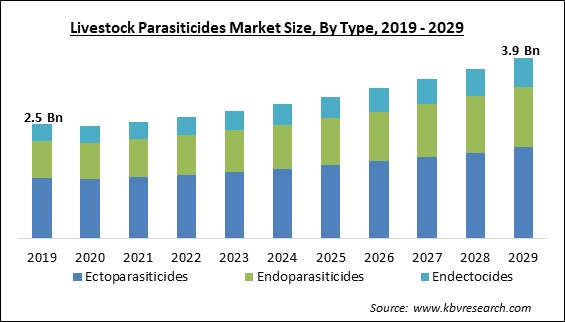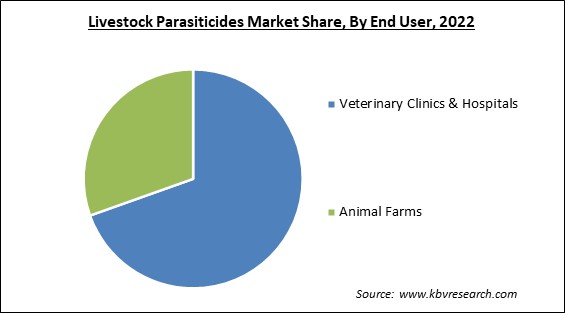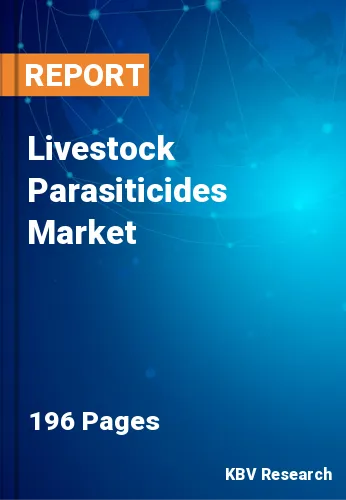The Global Livestock Parasiticides Market size is expected to reach $3.9 Billion by 2029, rising at a market growth of 5.9% CAGR during the forecast period.
Parasites are one of the most common causes of several diseases and loss of production in livestock. The market for livestock parasiticides aims to offer chemical compounds that eliminate parasites other than bacteria and fungi in animals. These chemicals are often innocuous components created in a composition that contains one or more active substances. Most parasiticides contain active components with similar chemical structures and numerous shared characteristics. They are additionally divided into many chemical classes and families.

The significance of livestock parasiticides for preventing and treating parasite illnesses in animals has been acknowledged. In order to combat the rising incidence of food-borne illnesses, numerous leading players and businesses from across the world are developing a variety of innovative formulations and products in the cattle parasiticides market.
The expanding demand for animal products in developing nations is mostly responsible for the increased demand for meat. Due to the rising population in different countries, the demand for meals derived from cattle has increased by an astounding 80% in the last 20 years. In addition, endoparasite-related illnesses have been shown to harm animals, ultimately reducing milk and meat production. Therefore, the primary drivers of the growth of the livestock parasiticides market are the need to limit the spread and infection of endoparasites among food-producing animals and the rising demand for animal protein globally.
It is true to argue that the COVID-19 pandemic has reduced the need for livestock animal care. As a result, most of the major players are currently functioning at a very low level or even completely incapable. Reduced output and capacity in veterinary pharmaceutical production would lead to product unavailability and hampered supply chains, negatively impacting market growth in 2020–2021. Leading businesses in the livestock healthcare industry saw a decline in the second quarter of 2020, which was attributed to declining demand in the companion animal sector, especially for clinically administered pharmaceuticals, in which social distancing measures led to fewer veterinary visits and increased working capital across the parasiticides value chain. In consideration of all these factors, the market has been negatively impacted by the widespread COVID-19 pandemic.
A significant growth element is projected to be the advancement of veterinary healthcare for livestock. Numerous governments and non-profit organizations worldwide are contributing to funding veterinary healthcare infrastructure. Modern veterinary facilities include cutting-edge medical equipment and a staff of highly trained professionals. As interest in animal healthcare grows, the market for livestock parasiticides is anticipated to grow. Privatization of government-owned businesses and introducing cost recovery were examples of institutional reforms, and eliminating tariffs and subsidies was an example of changes to financial, fiscal, and pricing policies.
The livestock industry is a crucial part of the global food system, much as agriculture contributes to various farming systems. The consumption of animal protein has increased dramatically worldwide due to rising consumer demand for it and rising consumer preference for diets high in protein and low in fat. As a result, there are now more livestock animals. According to the Food and Agriculture Organization (FAO), livestock accounts for a sizeable portion of the value of agriculture globally.
Most people worldwide often consume animal-based foods like meat as part of their daily diet. A different segment of the population also gets their protein from foods derived from animals. Vegetarians eat dairy products like milk and goods derived from milk. Given their direct interaction with people through food, animal-based products may be hazardous to human health. Therefore, strict regulatory rules are used by government ministries and federal entities to manage, regulate, monitor, and account for the diet, which includes food, supplements, fodder, medicines, and water.
Based on type, the livestock parasiticides market is segmented into ectoparasiticides, endoparasiticides, and endectocides. In 2022, the ectoparasiticides segment held the highest revenue share in livestock parasiticides. This is because animals are becoming more infested with fleas, ticks, and other ectoparasites, raising the risk of transmitting viral, bacterial, and parasitic diseases to humans. Ectoparasiticide use is therefore necessary and crucial for animals. Numerous causes, including the rising incidence of zoonotic and animal diseases and the rising frequency of parasitic infections in animals, contribute to the rise in demand for ectoparasiticides.

On the basis of end user, the livestock parasiticides market is categorized into veterinary clinics & hospitals, and animal farms. The animal farms segment garnered a significant revenue share in the livestock parasiticides market in 2022. Farmers and government officials take every measure possible to prevent these infections by keeping animal housing clean and immunizing livestock. In addition, to combat the rising prevalence of infections among livestock, several major players and businesses worldwide are developing numerous new formulations & products in the livestock parasiticides market, supporting the segment's growth.
By livestock, the livestock parasiticides market is fragmented into poultry, sheep & goats, cattle, and pigs. In 2022, the cattle segment witnessed the largest revenue share in the livestock parasiticides market. This rise in cattle numbers ultimately has a beneficial effect on the market for livestock parasiticides. Furthermore, as the demand for milk and other dairy products is continuously rising worldwide, the market is also predicted to grow in this segment.
| Report Attribute | Details |
|---|---|
| Market size value in 2022 | USD 2.7 Billion |
| Market size forecast in 2029 | USD 3.9 Billion |
| Base Year | 2022 |
| Historical Period | 2019 to 2021 |
| Forecast Period | 2023 to 2029 |
| Revenue Growth Rate | CAGR of 5.9% from 2023 to 2029 |
| Number of Pages | 196 |
| Number of Table | 350 |
| Report coverage | Market Trends, Revenue Estimation and Forecast, Segmentation Analysis, Regional and Country Breakdown, Companies Strategic Developments, Company Profiling |
| Segments covered | Type, End User, Livestock, Region |
| Country scope | US, Canada, Mexico, Germany, UK, France, Russia, Spain, Italy, China, Japan, India, South Korea, Singapore, Malaysia, Brazil, Argentina, UAE, Saudi Arabia, South Africa, Nigeria |
| Growth Drivers |
|
| Restraints |
|
Region wise, the livestock parasiticides market is analysed across North America, Europe, Asia Pacific, and LAMEA. In 2022, the North America region led the livestock parasiticides market by generating the highest revenue share. It is projected that the huge and growing animal population in the US & Canada will have a significant impact on the market growth in North America. This is backed up by a rise in veterinarian practices and simple accessibility to animal care.
Free Valuable Insights: Global Livestock Parasiticides Market size to reach USD 3.9 Billion by 2029
The market research report covers the analysis of key stakeholders of the market. Key companies profiled in the report include Boehringer Ingelheim International GmbH, Elanco Animal Health, Inc., Virbac, Zoetis, Inc., PetIQ, Inc., Merck & Co., Inc., Vetoquinol SA, Norbrook Laboratories Limited, Bimeda, Inc., and Ceva Santé Animale.
By Type
By End User
By Livestock
By Geography
The Market size is projected to reach USD 3.9 Billion by 2029.
Advancing Veterinary Care Infrastructure are driving the Market in coming years, however, Strict Regulations Defined to Use Animal Parasiticides restraints the growth of the Market.
Boehringer Ingelheim International GmbH, Elanco Animal Health, Inc., Virbac, Zoetis, Inc., PetIQ, Inc., Merck & Co., Inc., Vetoquinol SA, Norbrook Laboratories Limited, Bimeda, Inc., and Ceva Santé Animale.
The Veterinary Clinics & Hospitals market is leading the Market by End User in 2022; thereby, achieving a market value of $2.7 billion by 2029.
The North America market dominated the Market by Region in 2022; thereby, achieving a market value of $1.4 billion by 2029.
Our team of dedicated experts can provide you with attractive expansion opportunities for your business.

